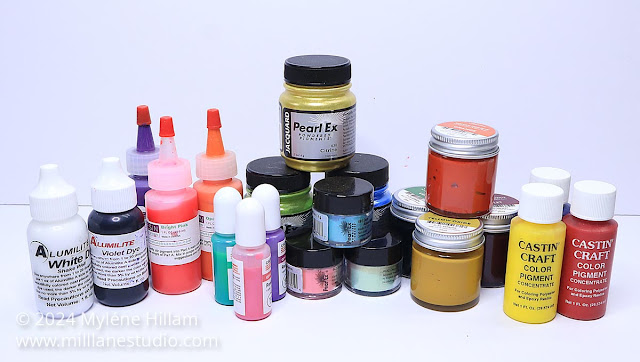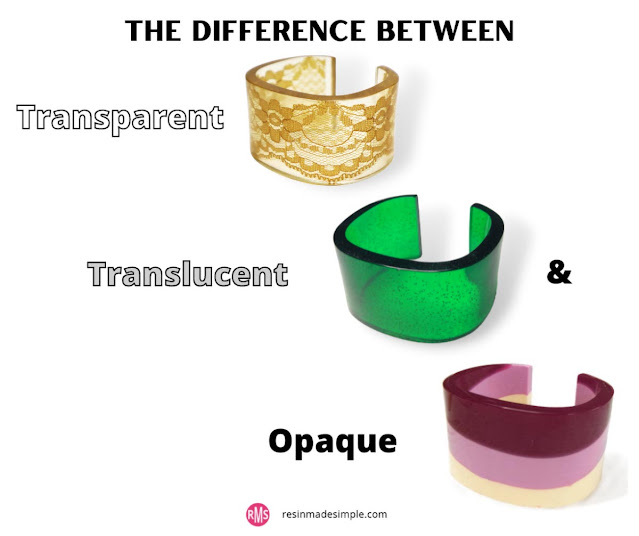Mixing and playing with colours in resin is fun and enjoyable, and it adds an
element of excitement to the creative process.
You can achieve stunning effects and breathtaking colour combinations. Think
vibrant marbling, captivating mica powder swirls, and bold colour-blocking -
each more exhilarating than the last!
You can mix and match opaque tones with translucent hues to create your own
unique colour palette.
With so many colour choices available, let's explore what types of colourants
work well in resin.
Resin Colourants - Colours Made for Resin
So firstly, what can you colour resin with?
The BEST colourants are those designed specifically for resin.
Resin pigments and dyes might be more expensive than other types of artists'
colourants but with good reason:
- They are formulated to WORK with resin. When you use resin pigments and resin dyes, you can relax knowing they won't react with the resin, so the resin will cure properly.
- They are highly concentrated, so you only need to use a small amount, making them more economical in the long run.
- They give you consistent, reliable colour. No hit-and-miss results, so you won't waste your expensive resin.
There are two types:
Resin pigments, which are typically opaque, and Resin dyes,
which are translucent.
- Resin pigments are available in several forms:
- powders
- pastes
- liquid
- Resin dyes are generally available as:
- liquid
- pastes
Other Types of Colourants
As well as resin pigments and dyes, there's a whole world of artist
colours that can be used in resin.
You can also use gold leaf and glitter but they stay in suspension (or sink)
rather than dissolving in the resin, so they are not true colourants.
Having said that, if you fill the resin with glitter or metal leaf (I mean, really stuff it full😜), it gives you the same effect as a colourant.
Issues with Using Other Colours
Earlier, I mentioned how reliable resin pigments and dyes are.
It's a different story for other types of colours, though. Some of them will
give you mixed results,
so you need to experiment a
little more with them. What works in one brand of epoxy, might not work in
another, so you need to test them in a small batch of resin before embarking
on a major project.
Colour Fading
Sometimes, you'll have strange things happen...
Have you ever seen the colour you're mixing into the resin disappear right
before your eyes?
I HAVE!
I dripped a couple of drops of purple alcohol ink into epoxy resin and mixed it in. And the colour disappeared into the epoxy. It was enough for me to do a double take. I know I added the alcohol ink... where had it gone?
So I added another couple of drops and stirred, and still, the resin was clear. The resin was bleaching the colour out! This is probably the most bizarre thing I've ever had happen with resin.
The strange thing is, I've used the other colours from the same range of alcohol inks in this resin, and they worked just fine. But for some reason, the purple didn't.
I've also seen alcohol ink bleach out overnight.
Alcohol inks often fade over time, so it's good to be aware of
that if you're selling your resin crafts. The last thing you want is an
unhappy customer.
Clumping and Stringiness
Acrylic paints are easy to obtain, and the range of colours is huge. They're
also budget-friendly.
But sometimes, acrylic paints can do strange things in resin:
- They can clump...
- or it can make the resin become stringy...
- or not mix in properly.
- They can even drastically shorten the work time from the usual 45 minutes to under 10 minutes!
But that doesn't mean you shouldn't try other art supplies. You just need to
test them in small batches to make sure you get the results you're expecting:
that the resin cures properly, without soft, sticky spots, and that the colour
is stable and doesn't discolour.
If you want to avoid these types of compatibility issues, USE RESIN PIGMENTS AND DYES.
Understanding Opacity in Resin
One of the characteristics of clear epoxy resin is that it accepts colour
really well and allows you to create different levels of opacity.
But what is opacity?
Opacity describes the amount of light that passes through an object. In resin,
you'll hear the terms opaque, translucent and transparent, and it can be
confusing to understand what they mean, especially when it comes to
translucency and transparency. This explanation might help.
Think of a church or cathedral.
There are doors, stained glass windows and regular windows.
- The doors are opaque. You can't see anything through them when they are closed.
- The stained glass windows are translucent. You can only see diffused light through them, but you can't see anything clearly.
- Clear windows. These are transparent and you can clearly see through them to see what is outside.
And it's the same for resin...
You can use this knowledge to help you understand what happens when you add
colour to resin.
OPAQUE colours are solid colours you can't see through, so you wouldn't
bother embedding anything in them. But you can create interesting effects
with them, like marbling and colour-blocking.
TRANSLUCENT colours have a glow about them. You may or may not be able to
see through them clearly, but if you hold them up to the light, you can see
light through them.
TRANSPARENT means clear. You'll be able to clearly see anything encased in
the resin and even see right through it, so this is perfect for embedding or
encasing objects inside.
This chart shows the opacity of each type of colourant you can colour resin
with. Download and print it.
So try those OTHER colourants if
you're feeling adventurous, but it is always safer to use colours that are
specifically designed for resin.
Regardless of which option you choose, colour
will undoubtedly open up a world of creative opportunities for you.
Learn even more about what you can colour resin with.

Subscribe to my email list and learn how to resin like an expert.
Pin This!
Happy Resining!

Subscribe to my email list and learn how to resin like an expert.








I love how you explain things, always so clear and easy to understand! Keep up the great work!!
ReplyDeleteThank you so much for your comment, France! Making resin topics understandable is always my goal, so I'm glad to hear that I'm hitting the mark. Your encouragement means a lot, and I'll definitely keep up the great work!
Delete